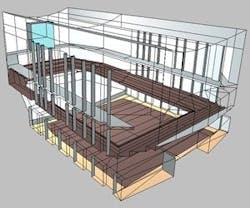Technology Transforms Architectural Drawings into Aural Renderings
Picture someone in a restaurant: The person watches his or her dining companion’s lips move, but can’t hear what he or she is saying over the din of other patrons. Or picture someone who can’t focus in a library because of all the distracting noises. Or, maybe worst of all, picture a concertgoer sitting in an ill-suited performance room, making a musical performance sound small and lifeless rather than present and enveloping.
Experiences like these are what make acoustics a critical aspect of building design. But how can you make the connection between the drawings of a future space and the aural experience of its future users?
A powerful tool, called auralization, is available to help make this connection. Using computer modeling and signal processing techniques, acoustical consultants can transform architectural drawings into realistic, surround-sound aural renderings of a space (an “auralization”) that allows you to “hear” your space before it’s built.
The Science of Listening
Although naturally suited for evaluating performance spaces, auralization can be used for rooms of any kind – from atriums, libraries, and dining halls to lecture halls, conference rooms, and offices.
Auralization relies on computer modeling software that simulates the propagation of sound within an enclosed space. A 3-D model of the space is built using CAD software, and this model is transferred to an acoustical modeling software package. The acoustical consultant assigns acoustical properties to the modeled room’s surfaces (or potential construction materials) and places sound sources and listener locations. The software then calculates the propagation of sound from the source to the listener using algorithms based on ray-tracing combined with statistical reverberation calculation and other techniques to account for sound scattering and diffraction. The calculated room impulse responses are then convolved with audio material that has been recorded anechoically – in a space free from echoes or reflections – to generate a realistic and listenable result (a piano recital, a busy wedding banquet, or a ceremonial speech as it will sound in the yet-to-be-built space).
Auralizations can be especially helpful when demonstrating the acoustical effects of a specific design. They can help you choose finish materials and refine the shaping of your space, and they can identify and communicate potential acoustical problems, such as echoes, poor speech intelligibility, and sound transmission between adjacent spaces. Equally, an auralization can empower the design team to make informed decisions about the cost effectiveness of various features, and can be an invaluable guide during the “value-engineering” or cost-cutting phase of a project. Above all, by giving you and the owner an opportunity to experience together the sound of a space while still in design, auralization can help to ensure agreement on the course of the design.
When Caritas Communities planned to buy a building in Chelsea, MA, the Braintree, MA-based nonprofit developer wanted to investigate the possibility of noise from the lively bar on the first floor intruding on the residences on the second and third floors, and to consider upgrades to the floor and ceiling constructions if necessary. Noise measurements were conducted in both spaces, and an auralization was created to allow the prospective developer to experience the sound environment in the residences during bar operation – with and without the recommended upgrades. Auralization gave the developer confidence to proceed with the purchase of the building and with the recommended upgrades.
As in any other discipline, acoustical consultants apply what they learn from one auralization to the next. They maintain large databases of material properties, which describe the acoustical attributes of different surfaces, and instruct the modeling software how sound interacts with each surface in a space. The auralization itself is presented in a well-equipped, acoustically treated, and calibrated listening room.
Practical Applications
It’s often difficult for architects to realize the practical effects of design features that acoustical consultants recommend. Auralization demonstrates why a certain design choice is preferred, allowing clients to judge for themselves the appropriate balance between competing considerations, such as cost, schedule, aesthetics, and acoustics.
The goal in the use of auralization is to allow clients to make confident and informed design decisions regarding the acoustics of their space. The cost of using auralization is usually quite reasonable in the context of the project, and affordable for most clients (and, very often, is a cost-saver for the project). Acoustics can help determine the success or failure of a space on the most concrete of measures: Is the space usable? Auralization can make a big difference in the outcome.
Jonah Sacks and Ioana Pieleanu are consultants at Acentech Inc. in Cambridge, MA.
